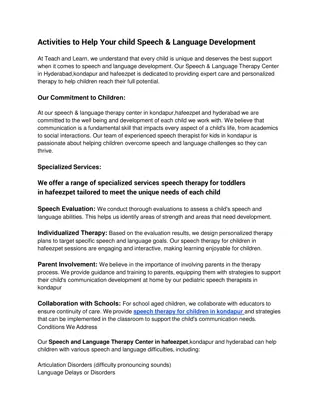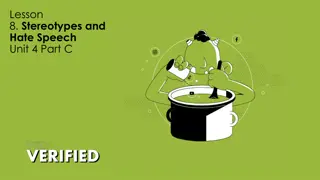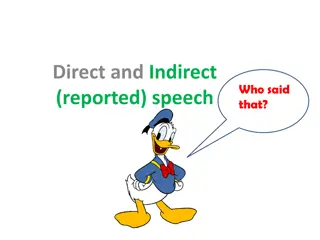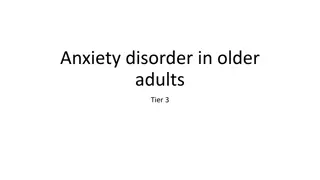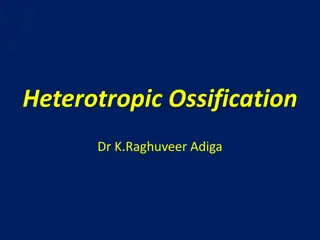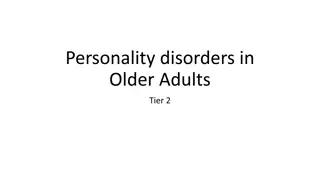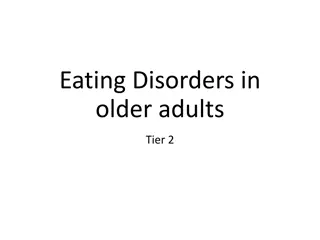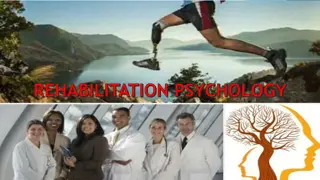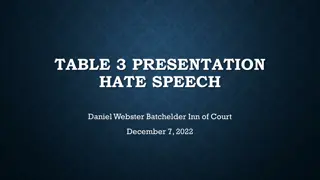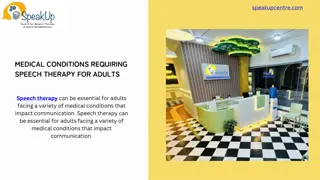Understanding Neurogenic Speech and Language Disorders in Adults
This chapter provides insight into language disorders in adults, including types of aphasia, causes such as toxins, traumatic brain injury, brain tumors, and strokes. It discusses cerebral hemorrhage, occlusive strokes, ischemic stroke, transient ischemic attacks, and cerebral thrombosis. The content covers the impact of neurogenic disorders on speech, language, swallowing, and cognitive functions, along with assessment and treatment approaches.
Download Presentation

Please find below an Image/Link to download the presentation.
The content on the website is provided AS IS for your information and personal use only. It may not be sold, licensed, or shared on other websites without obtaining consent from the author. Download presentation by click this link. If you encounter any issues during the download, it is possible that the publisher has removed the file from their server.
E N D
Presentation Transcript
Chapter 15 LANGUAGE DISORDERS IN ADULTS
You dont need to read P. 381-382 Transcortical sensory aphasia P. 382 conduction aphasia P. 383 transcortical motor aphasia
Outline I. Causes of Neurogenic Speech, Language, Swallowing, and Cognitive Disorders II. Types of Aphasia III. Assessment of Aphasia IV. Treatment of Aphasia
I. CAUSES OF NEUROGENIC SPEECH, LANGUAGE, SWALLOWING, AND COGNITIVE DISORDERS
B. Toxins** Drugs and alcohol They poison or cause inflammation of the CNS Wernicke-Korsakoff syndrome: present in severe alcoholics and caused by lack of thiamine--vitamin B1
E. Strokes (Cerebrovascular Accident; Brain Attack)** Average age--67 Risk factors: smoking, overweight, high blood pressure, aging, family history, lack of exercise There are different types of strokes
1. Cerebral Hemorrhage** 20% of all strokes high blood pressure is a huge risk factor Blood vessel ruptures Blood is forced into the brain tissue And destroys it
Cerebral Thrombosis** The brain artery gradually becomes blocked by debris in the blood Fatty substances accumulate on the lining of the arterial walls, leading to arteriosclerosis 50-100% of an artery may become blocked
II. TYPES OF APHASIA A. INTRODUCTION
B. Wernickes Aphasia** Fluent aphasia caused by damage around Wernicke s area in superior left temporal lobe Impaired comprehension, expression, reading, writing
C. Brocas Aphasia** Nonfluent aphasia Impaired syntax Still has content words Speech is effortful, slow, groping
A YouTube example: https://www.youtube.com/watch?v=RMa9BVpJkYQ Broca s aphasia Notice how he struggles to get the words out
E. Global Aphasia** Combination of fluent and nonfluent aphasia Most severe aphasia and caused by diffuse damage Significant receptive, expressive language and cognitive impairments Poor prognosis
YouTube Global Aphasia https://www.youtube.com/watch?v=FUutVGeoG-k Reel example-global aphasia
A. Expressive Language AbilitiesWe Test:** Speech systems respiration, phonation, resonance, articulation Confrontation naming Fill-in-blanks Describing pictures Conversation/discourse skills
C. Reading and Writing Abilities** Silently reading a story or paragraph and answering questions about it Writing words, letters, sentences dictated by SLP Formulating and producing written stories Reading aloud numbers, letters, words, phrases, sentences
IV. TREATMENT OF APHASIA** A. General Principles What does the patient s culture believe about rehab? Client s age, occupation, whether they want to go back to work Restorative approach improving underlying processes that are impaired e.g., teaching word recall strategies in functional situations Compensatory approach: strategies for persistent language deficits e.g., gestures, apps on devices
B. Receptive Skills Targeted** Auditory comprehension! Answering questions Following directions Answering questions about spoken discourse Following conversational speech
D. Train Communication Partners to:** Speak slowly Pause Shorter utterances; avoid long, complex sentences Augment speech with gestures and facial expressions When person has communicated to you, paraphrase what they said to make sure you understood it
E. Life Participation Approach** Increase competence and inclusion in daily life Help patients reintegrate back into their families and communities Strengthen their participation in activities of choice Provide support for caregivers
Outline I. Causes of Neurogenic Speech, Language, Swallowing, and Cognitive Disorders II. Types of Aphasia III. Assessment of Aphasia IV. Treatment of Aphasia




